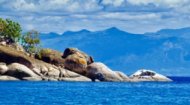Lake Malawi FactsTags: Lake Malawi, Lake Malawi Facts, Lake Malawi Environmental Challenges, Lake Malawi Ecological Significance, Lake Malawi Map, Lake Malawi Images |
|
Lake Malawi |
Lake Malawi |
Lake Malawi | Lake Malawi |
Lake MalawiThis remarkable adaptive radiation, where a single ancestral species rapidly diversified into countless forms occupying diverse ecological niches, is a textbook example of evolution in action. The cichlids of Lake Malawi exhibit an astonishing variety of shapes, sizes, colours, and behaviours, from tiny rock-dwellers to large predatory species, each intricately adapted to its specific habitat within the lake's complex ecosystem. Most of these species are endemic, meaning they are found nowhere else on Earth, making Lake Malawi a unique living laboratory for evolutionary biology. Beyond cichlids, the lake supports a variety of other fish, crustacean, mollusc, and insect species, contributing to a rich and complex food web. The surrounding terrestrial environment also benefits from the lake's presence, supporting diverse birdlife, including fish eagles and various waterbirds. The ecological significance of Lake Malawi extends far beyond its scientific value. It serves as a vital freshwater resource for the surrounding communities, providing water for drinking, sanitation, and agriculture. The lake's vast expanse influences regional climate patterns, contributing to rainfall and maintaining a stable environment for terrestrial ecosystems along its shores. Its clear waters are also a significant draw for tourism, attracting snorkelers, divers, and scientists eager to witness its underwater spectacle. Economically and socially, Lake Malawi is the lifeblood for millions of people. Fisheries are a cornerstone of the regional economy, providing a primary source of protein and income for local communities. The lake's fish, particularly species like chambo (various Oreochromis species), are a staple in the Malawian diet. Beyond sustenance, the fishing industry supports a vast network of traders, processors, and transport operators, sustaining countless livelihoods. Tourism, burgeoning in recent decades, also contributes significantly to the economies of the riparian countries. Resorts, lodges, and tour operators cater to visitors drawn by the lake's natural beauty, the allure of its unique fish, and opportunities for water sports and cultural interaction. Furthermore, the lake serves as an important waterway for local transportation and trade, connecting remote communities that are otherwise difficult to access by land. Despite its immense importance, Lake Malawi faces significant environmental challenges. Overfishing is a pressing concern, driven by increasing population pressure and the use of unsustainable fishing methods, leading to declines in fish stocks, including commercially important species. Pollution from agricultural runoff, industrial waste, human sewage, and plastic debris poses a growing threat to water quality and aquatic life. Climate change is emerging as another major concern, with rising water temperatures potentially impacting cichlid breeding cycles and the lake's delicate thermal stratification, while altered rainfall patterns could affect water levels and nutrient flow. Habitat degradation along the shoreline, caused by deforestation, uncontrolled development, and sand mining, further exacerbates these issues. Recognising these threats, concerted conservation efforts are underway. Governments, local communities, non-governmental organisations, and international partners are working collaboratively to implement sustainable fishing practices, establish protected areas, monitor water quality, and raise awareness about the lake's fragility. Research initiatives aim to better understand the lake's ecosystem dynamics and the impacts of environmental change. International cooperation among the riparian states is crucial for effective management of this shared resource. Lake Malawi embodies a critical paradox: a place of extraordinary natural wealth that is simultaneously vulnerable to human pressures. Its unique evolutionary heritage, deep cultural significance, and vital economic role underscore the urgent need for its protection. Preserving the beauty and biodiversity of Lake Malawi is not just about safeguarding a natural wonder; it is about sustaining livelihoods, championing scientific discovery, and ensuring a healthy future for the heart of Africa. |








